case studies
Dobsons Creek disconnection project
Contact
Insight:
Improving the health of a high ecological value waterway with stormwater disconnection
Project description
Dobsons Creek has the highest ecological value of any waterway within the Knox City Council area, and is one of the highest value waterways in the wider Dandenong Creek catchment. In 2010, Melbourne Water and Knox City Council initiated a pilot program to retrofit the 1300 hectare Dobsons Creek catchment with stormwater disconnection measures on public and private land. The pilot program involved the retrofitting of a large-scale parkland bioretention system, installation of ‘leaky’ rainwater tank on over 180 properties in the catchment, and streetscape water sensitive urban design (WSUD) retrofit projects.
Governance logic and project structure
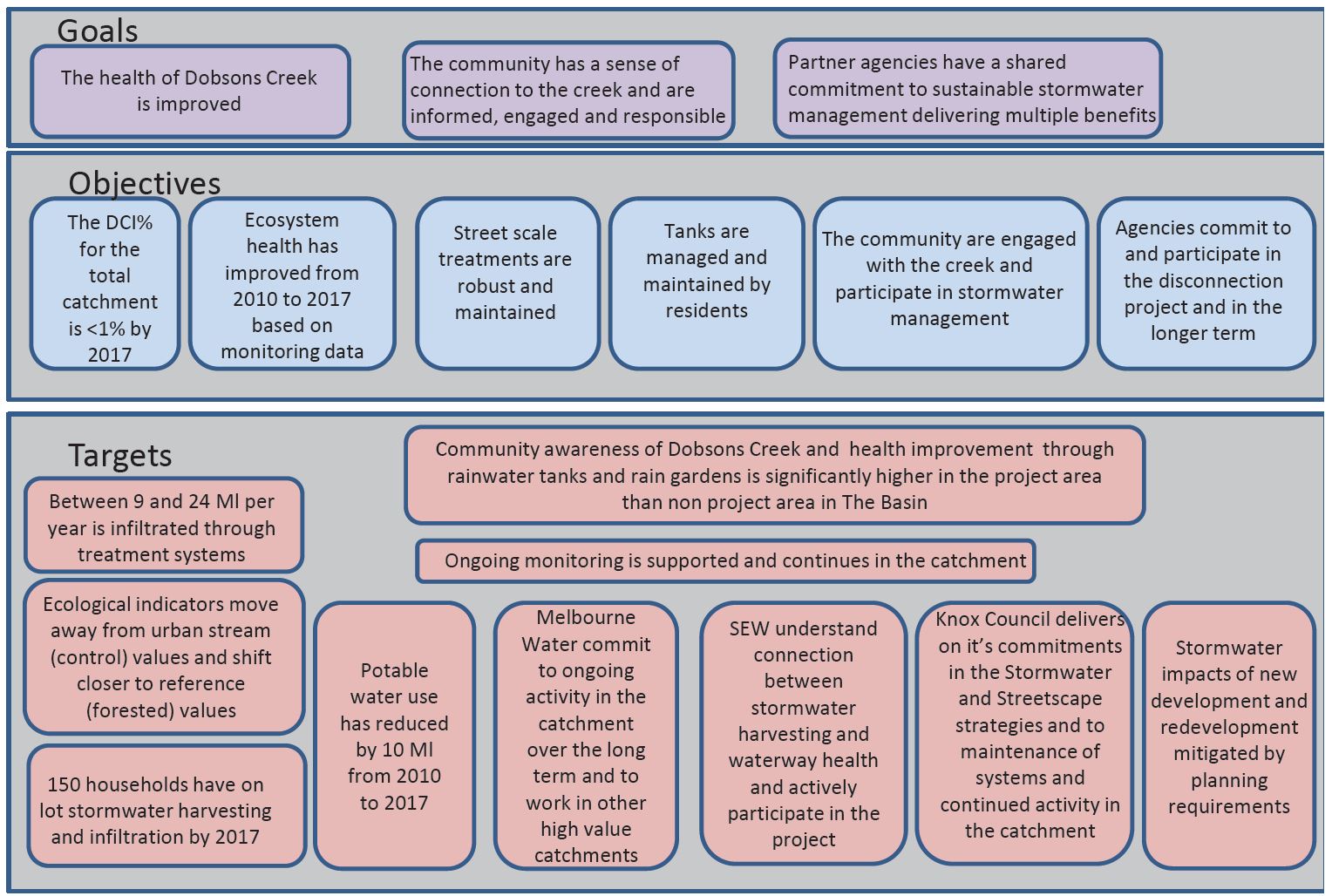
The drivers
Test the viability of improving waterway health through catchment retrofit by industry
- To improve the health of one of the highest ecological value waterways in the Dandenong Creek catchment by disconnecting impervious surfaces in both public and private lands to restore pre-developed catchment hydrology.
- Develop a community that has a sense of connection to the creek, and is informed, engaged and responsible.
- Build from the experience of the Little Stringybark Creek project which researchers used to demonstrate the impacts of directly connected impervious (DCI) on waterway health and the potential of improving this through catchment retrofits.
- Understand how agencies can work together to deliver catchment retrofits and identify the actual costs to undertake this work with the aim of mainstreaming this approach in the future.
The innovations
Collaboration across agencies to reverse directly connected impervious (DCI) impacts through catchment retrofit
- Retrofitted a large scale parkland bioretention system: A large 1,900m2 bioretention system was constructed into the Wicks Reserve to disconnect and treat an 11.5ha portion of the Dobsons Creek catchment.
- 'Leaky' rainwater tank retrofits: Over 180 properties in total have been retrofitted with a maximum of three 4.5 kL rainwater tanks on each property. The tanks are connected to the toilet and/or laundry and also came with a dripper hose that leaks water very slowly into an adjacent garden or lawn area which passively irrigates the landscape and also ensures there is storage volume in the tank each time it rains. Residents also received downpipe diversion units on downpipes that are not connected to a rainwater tank. Around 150 residents received the tanks free of charge in a first round of the Tanks for helping our Creek program.
- Market driven investment in rainwater tank retrofits: A second round of the Tanks for helping our Creek program was offered to residents, except this time a market based instrument approach was tested. This involved a tender approach which asked interested residents to put in an offer to pay towards the cost of installing the tank, with Melbourne Water to cover the rest. The higher the offer, the more likely they were to be successful. An additional 33 properties secured the rainwater tanks through this approach.
- Streetscape WSUD retrofits: Investigations identified a large proportion of the impervious areas in the catchment were road surfaces. Roads were prioritised based on their suitability for WSUD retrofit by considering slope, catchment area, land use, presence/absence of drainage infrastructure and availability of space within the road reserve. Based on this analysis, a number of WSUD treatment train systems have now been retrofitted into several streetscapes by Knox City Council.
Connected and unconnected impervious areas
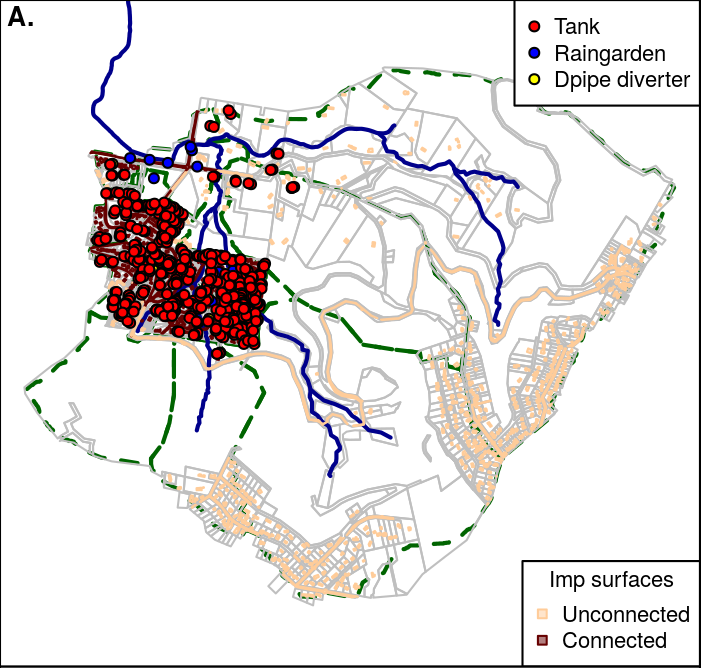
The lessons
- Benefits in using technologies previously tested in research: Outcomes from the Little Stringybark Creek project have been invaluable in the Dobsons Creek project. For example, the leaky tanks were easily adopted after they had already been proven successful in the Little Stringybark Creek project.
- Trust is needed between agencies and community to deliver catchment retrofits: A key aim for the project was to test the viability of agencies and the community to work together to overcome a perceived lack of trust. Engagement between the agencies and community through this process has been very positive. The community has also had trust in the on-lot solutions because the program was clearly communicated and the works were delivered efficiently by an experienced ‘on-the-ground’ contracted plumber.
- Inter-agency collaboration is critical but can also cause delays: To be able to deliver these retrofit works across the public and private lands, inter-agency collaboration was crucial because all agencies have differing levels of influence, jurisdiction, objectives and capacity. However, bringing all three agencies together extensively to plan and deliver the project was time consuming. To address this issue, the project eventually split into solutions for private lots and streetscape public lands which allowed the common outcomes of the project to be met but also allowed the projects to progress at their own pace.
- Retrofit can be expensive: Despite projected cost savings through economy of scale, retrofitting a catchment is an expensive undertaking. The streetscape and parkland retrofits were cheaper to implement than the private on-lot solutions, but these on-lot solutions will have negligible operation and maintenance costs for the agencies because they will be managed by the property owner.
Transferability
Retrofit projects to disconnect impervious areas are applicable globally and have an important role to play in waterway improvement. however, the Dobsons Creek catchment is a peri-urban catchment with only 2% DCI. Highly developed catchments that have higher levels of DCI would find it difficult to achieve the reduction to under 1% DCI.
Project stats
Location
Melbourne, VIC, Australia
Awards
Stormwater Victoria Excellence in Infrastructure Award in 2011
UN Association of Australia World Environment Day Award for Sustainable Water Management in 2012
Finalist in the National Stormwater Awards for Excellence in 2012
Stormwater Australia Award for Excellence in Research and Innovation 2016
Additional information
Stormwater Australia Conference Proceedings (Prosser, Catchlove, et al.)
Water Sensitive Urban Design 2012 Conference Proceedings (Lewis, Catchlove, et al.)
More research to be released by the University of Melbourne (Walsh, C.J., Fletcher, T.D., et al.)
Contact
Get in touch
The outcomes
 Cities providing ecosystem services
Cities providing ecosystem services

- Catchment disconnection achieves less than 1% DCI: Retrofit projects across the catchment have reduced directly connected imperviousness from around 2% to less than 1% in the full catchment, and to 1.4% in the smaller main monitoring catchment.
- Wicks Reserve bioretention system reduces storwmater flows and pollutant loads entering creek with great success: Monitoring from 96 rainfall events showed an 80% reduction in the magnitude of flows, and total suspended sediments (TSS), total phosphorus (TP) and total nitrogen (TN) reductions of 98%, 89% and 77% respectively.
 Cities as water supply catchments
Cities as water supply catchments

- Retrofitted rainwater tanks reduce potable water consumption: Connecting rainwater tanks to the toilet and laundry can result in a 30% reduction in potable water use.
 Cities comprising water sensitive communities
Cities comprising water sensitive communities

- Private landholders part of the solution: The community has supported the project as demonstrated through the significant uptake of on-lot rainwater tanks.
Interested in this solution?
We partner with small and large companies, government and industry in Australia and around the world.
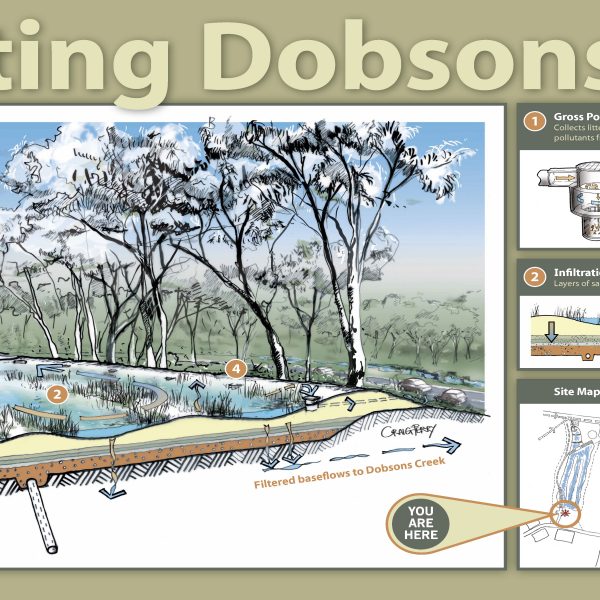
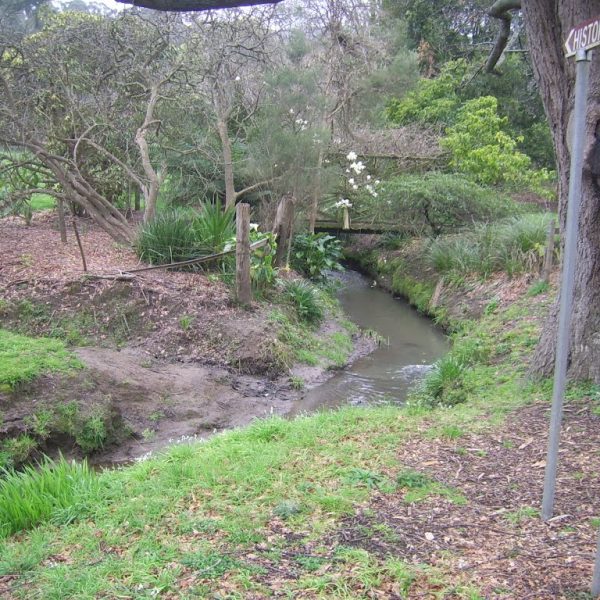
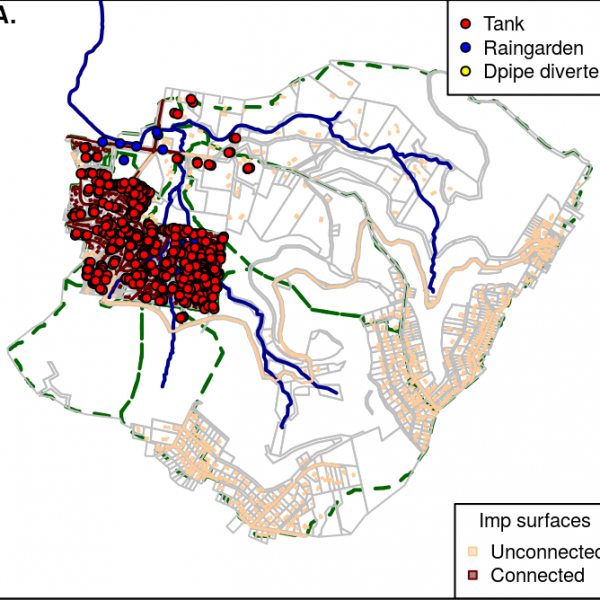
Comments